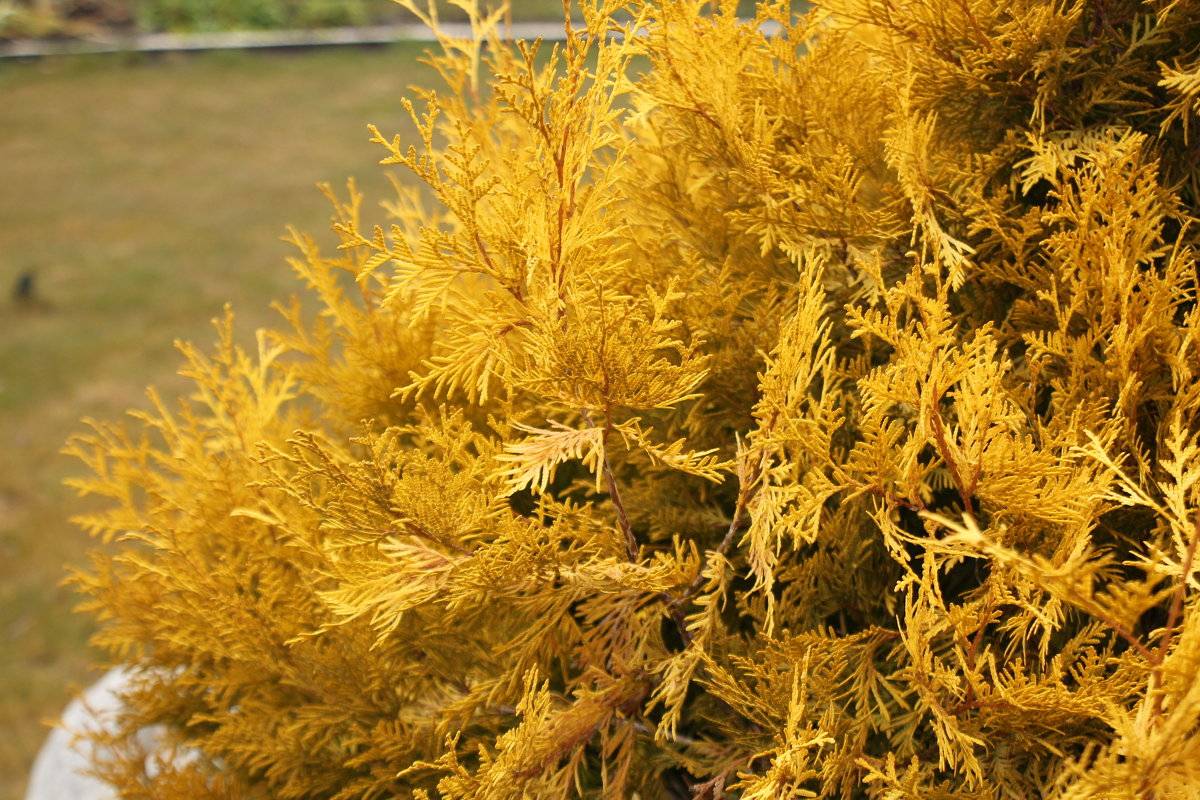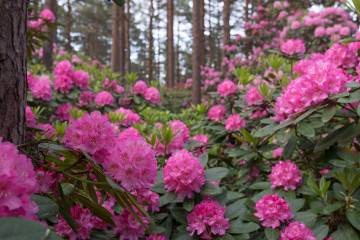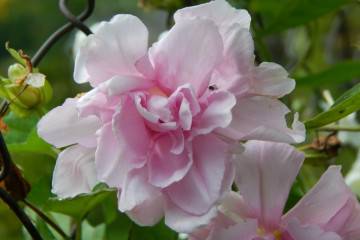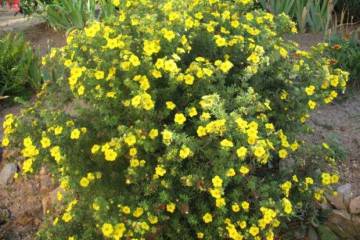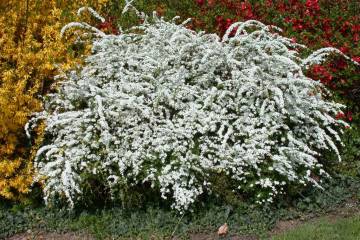Tuya Brabant - description and size, fit and care
Content:
Tuyu Brabant is also called Western. It is most common in cold Russia. This is due to its appearance, the speed of annual growth, increased frost resistance and unpretentiousness.
Thuja Brabant
Thuja Brabant is grown by gardeners from the Moscow region to Siberia itself. Everywhere it takes root and develops successfully, decorating summer cottages and fulfilling all the fantasies of landscape designers.
Description and dimensions
Botanical description of thuja Brabant:
- life form - tree;
- cone-shaped plant;
- branches are frequent, dense, starting to grow almost at the very ground, so the trunk is practically invisible;
- the bark is grayish, peels off easily;
- the needles are light green, does not change color depending on the season;
- the root system is fibrous, powerful;
- small flowers are collected in inflorescences, appear in spring;
- the fruit is a box.
The maximum tree height in natural conditions is 20 m.But plants planted in garden plots grow no more than 5 m.The diameter of the lower crown of a thuja reaches 4 m.
Thuja Brabant hedge
Most often, Brabant is used precisely to create hedges that look incredibly impressive. Thuja grows quickly and does not require serious care. But it is worth noting that this tree is grown as a solitary one. It takes root easily and feels comfortable.
Pruning thuja Brabant
Thuja Brabant needs pruning twice a year. For the procedure, use a sharp, disinfected secateurs. The plant is pruned for the first time in March. The second procedure is carried out in the summer, 6 months after the first. This allows you to form a lush and dense crown of the correct shape.
Step-by-step instructions for pruning:
- All dried, damaged branches should be trimmed.
- Each branch is shortened by no more than 1/3. In this case, you should try to give the plant a certain shape. In this case, it is worth stopping at the shape of the cone - this is natural for the Brabant variety.
- Thuja should be trimmed only on cloudy days to protect the cut points and injured branches from sunburn.
- After completing the procedure, the trees should be well watered.
How fast does thuja grow
The annual growth rate with proper care is quite rapid. It is about 30 cm in height, and in width Brabant increases by 10-12 cm annually.
Thuja Brabant root system
The root system is fibrous, spreads over a fairly wide distance, and lies close to the soil. While the thuja is germinating in containers, the root system is quite compact, after planting in open ground it grows rather quickly.
Thuja Brabant - planting and care
The first step to successful growing is choosing the right, proven nursery. Thuja's reaction to unfavorable conditions is slow, but inevitable. Therefore, it may happen that the seedling was damaged in the store, and after transplanting it dies. The gardener will not be guilty here, but it is he who will have to worry and look for problems. It is difficult to distinguish a diseased plant from a healthy one at first glance. The first indicator will be that the seedling is too cheap. The roots should be clean, white, rather thin - up to 3 mm in diameter. The optimum plant height is 20-100 cm.
How to plant thuja Brabant
Planting time depends on the type of root system of the seedling. Thuja with open roots are planted in March-April. The closed root system allows planting not only in April, but also in October. Planting thuja Brabant in open ground:
- A landing pit 75x100 cm is being prepared. When planting a hedge, a trench of the same depth is dug.
- 10 cm of expanded clay or a large river stove is poured onto the bottom to ensure good drainage.
- In the center of the hole, a mound of nutrient soil is created, over which the roots are neatly distributed. If the root system is closed, it is possible to plant by transshipment without dividing the roots.
- The pit is covered with a substrate prepared in advance.
There is no need to tamp, since the roots need a regular flow of air. To avoid excessive evaporation of liquid from the soil surface, you can build a small roller no more than 20 cm high around the planting pit or along the trench.
Site selection and soil preparation
The best option for landing is partial shade. Saplings can be placed along the fence or near buildings. You can immediately purchase ready-made soil for conifers, but it will take too much money to plant a whole hedge. Therefore, you can prepare the soil yourself:
- 3 pieces of turf;
- 1 part sand;
- 1 part peat.
Mandatory plant care
Proper care is very important for young plants. It should be provided for the first few years of life, in return the plant will thank in the future. Basic rules of care so that thuja Brabant can grow and develop:
- regular watering, which is carried out every 3-4 days. Pour 10 liters of water under each bush;
- it is necessary to loosen the soil regularly. But the depth of loosening should be no deeper than 10 cm. This procedure can be replaced by mulching with natural material;
- regular weeding. As soon as weeds appear, they need to be destroyed. This is especially true for weeds with a taproot system.
Typical diseases and pests
By the appearance of thuja Brabant, it immediately becomes clear that she has some kind of problems associated either with improper care, or with the appearance of diseases and insect pests. The appearance of a diseased tree is fundamentally different from a healthy one. Of insects, weevils and wireworms can deliver special problems. In both cases, special insecticides will help. But weevils (larvae) can be destroyed by liming the soil.
Other problems and illnesses:
- late blight first affects the roots, and then damages the crown. The plant begins to wither quickly, the needles become gray and sticky.The reason may be over-watering or waterlogging of the soil. Fungicides will help to cope with the problem;
- fusarium causes drilling of the ground part of the plant. All damaged shoots must be removed, everything else must be treated with Fundazole;
- rust most often occurs in early spring. As a result, the needles begin to darken and fall off. Special fungicides containing copper will help;
- thuya aphid. It is easy to distinguish it from other pests, since it actively begins to move on the branches, which, as a result of its active influence, dry very quickly. The best drug to combat it "Karbofos".
Thuja Brabant - needles turn yellow
With the loss of the attractive appearance of thuja Brabant, it is not always worth shifting the responsibility to fungal diseases or pests. Sometimes the problem is the lack of elements. In particular, yellow foliage can indicate that there is not enough nitrogen in the soil. By the way, foliage can also turn yellow due to the fact that pets have taken the soil near the plant for the place of fulfillment of their own needs. They should definitely be weaned from this.
Preparing for winter
This variety of thuja can withstand frosts down to -35 ° C, so adult trees do not need additional shelter, they will calmly survive the winter in the Central and Middle regions of the country. If the frosts are expected to be stronger, the thuja should be covered for the winter with special garden material. The same operation is necessary for young bushes up to the age of five. The soil at the bottom needs to be piled up to a height of about 15 cm, and covered with spruce branches around the same way as the lower part of the trunk.
Tui Smaragd and Brabant: differences
Thuja Smaragd, like Brabant, belongs to the Western type of thuja. They are very similar in appearance, but they are 2 different varieties. Tuya Smaragd and Brabant differences:
- the annual growth rate of Smaragda is lower. Even in the first years of life, it is only about 20 cm. For some, this indicator is decisive, and some gardeners just prefer the slow-growing option;
- the Brabant variety needs to be pruned every six months, while the Smaragd variety requires the usual annual formative pruning;
- despite the fact that Brabant prefers partial shade, growth and development will stop in absolute shade, and the opponent can endure shaded areas, this difference is also important;
- Smaragd is able to endure even lower temperatures down to -45 ° C without shelter;
- Smaragd is more compact, so more copies will be required to create a hedge.
Both varieties are long-livers, but the frost lover is slightly inferior in this indicator. However, the age of both thuja and thuja is easy to step over the age. Therefore, they will delight gardeners for several generations at once. It is impossible to say which is better - Tuya Smaragd or Brabant. For everyone there is his own, individual series of criteria, according to which he chooses the variety that is necessary for him. For example, residents of the northern regions will decide to play it safe and have a more frost-resistant Smaragd.
Features of growing thuja Brabant
Thuja Brabant is an unpretentious plant. The main thing is to prepare the correct pit with good drainage when planting, make up a suitable air and moisture permeable soil mixture and apply fertilizers. Further care is simple - watering, formative pruning, loosening or mulching the soil and weeding.
Landscape designers adore this variety for its visual appeal, good growth and ease of care.Therefore, its representatives are easy to find not only in private territories, but also in city gardens, parks, squares. They look spectacular with flowers planted in the foreground of the composition. The fresh greens of Brabant bring out the vibrancy and color of herbaceous plants or shrubs.
These trees look great in compositions located at the porch. You can put a table or a gazebo next to them and enjoy tea drinking or reading books in hot weather in a pleasant partial shade.
Thuja Brabant is a good choice for gardeners who love the growth rate and unpretentiousness of the plant. It is better that there is a lot of space in the garden, since the tree will be quite tall and wide. It is convenient to use it as a hedge, this thuja looks just great. Everyone will be able to master the art of planting such trees, even those who have never been involved in plant growing before.




